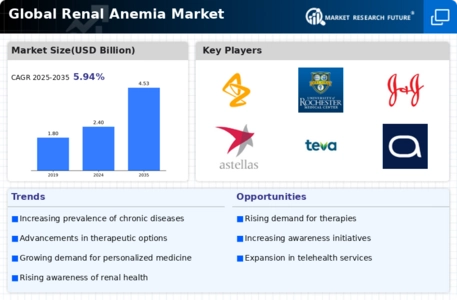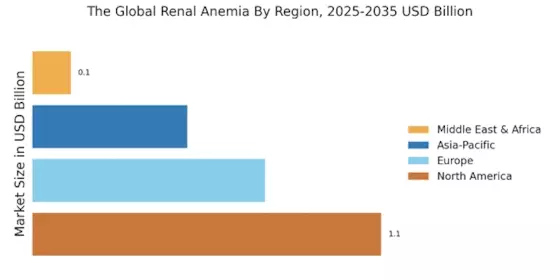Growing Geriatric Population
The aging population is a significant factor contributing to the growth of The Global Renal Anemia Industry. As individuals age, the risk of developing chronic conditions, including renal disease, increases. The World Health Organization estimates that by 2050, the number of people aged 60 years and older will double, reaching over 2 billion. This demographic shift is likely to result in a higher prevalence of renal anemia, as older adults are more susceptible to kidney dysfunction and related complications. Consequently, healthcare systems will need to adapt to this changing landscape, leading to increased demand for renal anemia treatments. The Global Renal Anemia Industry is poised to benefit from this trend as providers seek to address the unique healthcare needs of the elderly.
Rising Healthcare Expenditure
The increase in healthcare expenditure across various regions is a crucial driver for The Global Renal Anemia Industry. Governments and private sectors are allocating more resources to healthcare, which includes funding for renal disease management and treatment options. According to the World Bank, global health expenditure has been on the rise, with many countries prioritizing chronic disease management. This trend is likely to enhance access to renal anemia therapies, as more patients can afford treatments and healthcare providers can invest in advanced technologies. As healthcare systems evolve to meet the needs of patients with renal anemia, The Global Renal Anemia Industry is expected to experience robust growth, reflecting the increasing financial commitment to health and wellness.
Increased Focus on Preventive Healthcare
There is a growing emphasis on preventive healthcare, which is shaping The Global Renal Anemia Industry. Healthcare providers are increasingly recognizing the importance of early diagnosis and management of renal anemia, particularly in patients with underlying kidney conditions. This shift towards preventive measures is supported by initiatives aimed at improving screening and awareness of kidney health. As a result, more patients are being diagnosed at earlier stages, leading to timely interventions and better health outcomes. The market is likely to expand as healthcare systems invest in preventive strategies and education, ultimately driving demand for renal anemia treatments. This proactive approach may also reduce the long-term healthcare costs associated with advanced renal disease.
Rising Prevalence of Chronic Kidney Disease
The increasing incidence of chronic kidney disease (CKD) is a primary driver for The Global Renal Anemia Industry. As CKD progresses, it often leads to renal anemia, which affects a significant portion of the population. According to recent data, approximately 10% of the global population is affected by CKD, with a notable rise in cases attributed to diabetes and hypertension. This growing patient base necessitates effective treatment options, thereby propelling the demand for renal anemia therapies. The market is expected to expand as healthcare providers focus on managing CKD and its complications, including anemia. Consequently, The Global Renal Anemia Industry is likely to witness substantial growth as more patients seek interventions to improve their quality of life.
Technological Advancements in Treatment Modalities
Technological innovations in treatment modalities are significantly influencing The Global Renal Anemia Industry. The development of novel erythropoiesis-stimulating agents (ESAs) and iron supplementation therapies has transformed the management of renal anemia. These advancements not only enhance treatment efficacy but also improve patient compliance and outcomes. For instance, the introduction of biosimilars has made therapies more accessible and cost-effective, potentially increasing market penetration. Furthermore, ongoing research into gene therapy and regenerative medicine may offer new avenues for treatment in the future. As these technologies continue to evolve, they are expected to drive The Global Renal Anemia Industry forward, catering to the needs of an expanding patient population.


















Leave a Comment